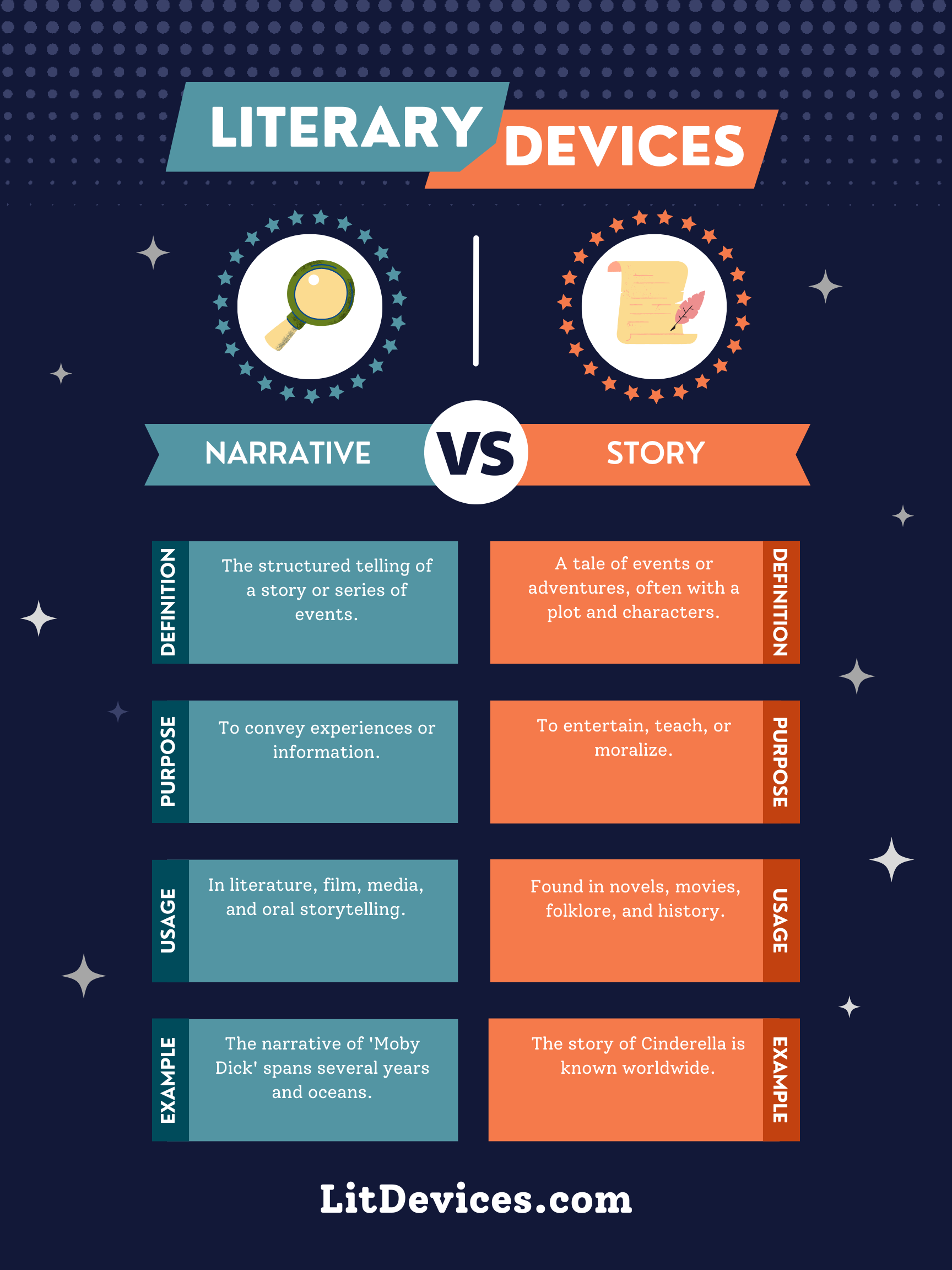Narrative refers to the structured telling of a story; Story is the sequence of events told in the narrative.
Narrative
Narrative is the way a story is told, including the structure, perspective, and the stylistic choices made by the author. It encompasses the method and manner in which the story is delivered to the reader or audience.
🌟 Example: In “Wuthering Heights” by Emily Brontë, the narrative is presented through the eyes of multiple narrators, adding layers of perspective and depth to the storytelling.
Story
Story refers to the actual events and characters that comprise the plot, regardless of how they are arranged or delivered in the narrative. It is the raw material of the events and interactions that occur.
📚 Example: The story of “Romeo and Juliet” by William Shakespeare involves two young lovers from feuding families who ultimately meet a tragic end.
Summary
| Literary Device | Definition | Purpose | Usage | Relevant Examples |
|---|---|---|---|---|
| Narrative | The structured telling of a story, including the choice of narration, structure, and style. | To convey the story to the reader or audience in an engaging and coherent manner. | Utilized in all forms of storytelling, from novels and short stories to films and oral traditions. | The nonlinear narrative of “Pulp Fiction.” |
| Story | The sequence of events and characters that make up the plot. | To provide the foundation and framework for the narrative. | The core of any literary work, around which the narrative is constructed. | The timeless story of “Cinderella,” adapted into various narratives across cultures. |
Writing Tips
When crafting your own narratives or stories:
- For Narrative: Focus on how you’re telling your story. Play with different perspectives, structures, or timelines to see how they change the reader’s experience. Consider your voice and how it affects the atmosphere and depth of the narrative.
- For Story: Work on the fundamentals of your plot and characters. Ensure you have a compelling arc, with clear motivations for your characters and a satisfying resolution. The story is the backbone of your work; make it strong.
🖋 Example for Narrative: Experiment with an unreliable narrator to add mystery or complexity to the telling of a straightforward story.
🖋 Example for Story: Develop a simple but powerful story arc, such as a hero’s journey where the protagonist overcomes various obstacles to achieve their goal, then brainstorm different ways to narrate this journey.
FAQs
Can a narrative change while the story remains the same?
Yes, the narrative can vary widely in the telling of the same story through different perspectives, structures, or styles, affecting the audience’s perception and understanding.
Is one more important than the other?
Both are integral to the creation of a literary work. The story provides the content, while the narrative determines how that content is shared and experienced.
Can there be a narrative without a story?
Narratives typically require a story to tell, though the story might be minimal. Some avant-garde or experimental works focus more on the method of narration than on the plot itself.
Exercise
Determine whether the following descriptions are more indicative of narrative or story:
- A tale about a knight rescuing a princess from a dragon.
- A novel that begins at the end and slowly reveals how the characters arrived at the conclusion through flashbacks.
- The central conflict involves a family torn apart by a will.
- A movie told from the perspective of the villain, providing a new take on a classic hero’s journey.
Answers:
Interesting Literary Device Comparisons
- Point of View vs. Perspective: Point of view refers to the narrative voice through which a story is told (first-person, second-person, third-person), while perspective is the lens through which characters, narrators, or authors view the events of the story, influenced by their personal experiences and biases.
- Character vs. Characterization: Character refers to an individual in a story, while characterization is the process by which the author reveals the personality, traits, and motivations of that character, either directly or indirectly.
- Plot vs. Theme: Plot is the sequence of events that make up the story, driven by characters’ actions and decisions. Theme, on the other hand, is the central idea or message the story explores, providing insight into

